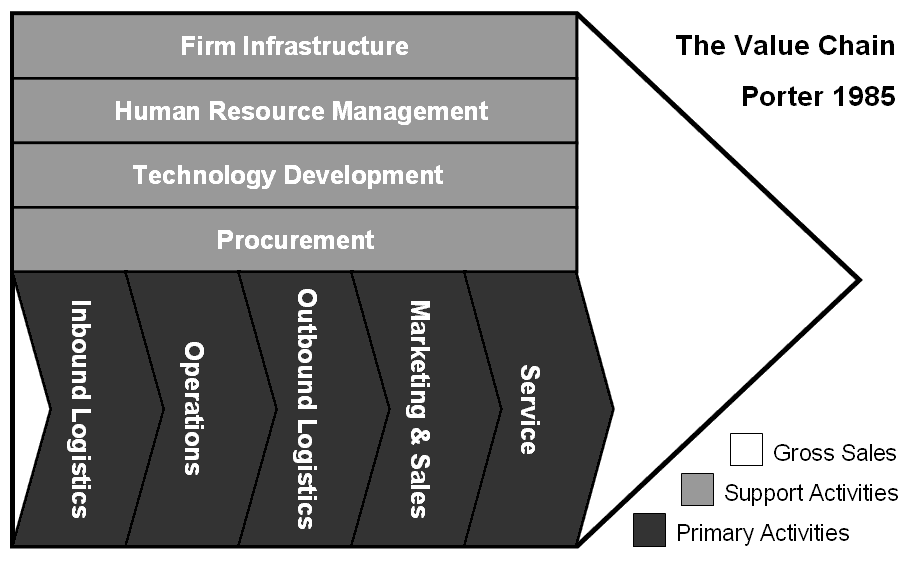Strategic Planning with the Value Chain Framework
Value Chain is a technique that enables better strategic planning in business.
A value chain is a chain of activities. Products pass through all activities of the chain in order and at each activity the product gains some value. The chain of activities gives the products more added value than the sum of added values of all activities. It is important not to mix the concept of the value chain with the costs occurring throughout the activities. A diamond cutter can be used as an example of the difference. The cutting activity may have a low cost, but the activity adds much of the value to the end product, since a rough diamond is significantly less valuable than a cut diamond.
 The value chain categorizes the generic value-adding activities of an organization. The primary activities include:
inbound logistics, operations (production), outbound logistics, marketing and sales (demand), and services (maintenance).
The support activities include: administrative infrastructure management, human resource management, technology (R&D), and
procurement. The costs and value drivers are identified for each value activity. The value chain framework quickly made its
way to the forefront of management thought as a powerful analysis tool for strategic planning. The simpler concept of value
streams, a cross-functional process which was developed over the next decade, had some success in the early 1990s.
The value chain categorizes the generic value-adding activities of an organization. The primary activities include:
inbound logistics, operations (production), outbound logistics, marketing and sales (demand), and services (maintenance).
The support activities include: administrative infrastructure management, human resource management, technology (R&D), and
procurement. The costs and value drivers are identified for each value activity. The value chain framework quickly made its
way to the forefront of management thought as a powerful analysis tool for strategic planning. The simpler concept of value
streams, a cross-functional process which was developed over the next decade, had some success in the early 1990s.
The value-chain concept has been extended beyond individual organizations. It can apply to whole supply chains and distribution networks. The delivery of a mix of products and services to the end customer will mobilize different economic factors, each managing its own value chain. The industry wide synchronized interactions of those local value chains create an extended value chain, sometimes global in extent. Porter terms this larger interconnected system of value chains the value system. A value system includes the value chains of a firm's supplier (and their suppliers all the way back), the firm itself, the firm distribution channels, and the firm's buyers (and presumably extended to the buyers of their products, and so on).
Capturing the value generated along the chain is the new approach taken by many management strategists. For example, a manufacturer might require its parts suppliers to be located nearby its assembly plant to minimize the cost of transportation. By exploiting the upstream and downstream information flowing along the value chain, the firms may try to bypass the intermediaries creating new business models, or in other ways create improvements in its value system.
Other Strategic Planning Frameworks
- 4P's Marketing Mix
- Seven S (7S) Management Framework
- AIDA - Attention, Interest, Desire, Action - Buying Process
- Ansoff's Matrix - Product-Market Growth Matrix - Expansion Strategy
- BCG Growth-Share Matrix
- Bass Diffusion Model - Product Adoption and Innovation
- Blue Ocean Strategy
- Choice Model for Decision-Making Behavior
- Competitive Advantage
- Core Competence - Collective Learning in the Organization
- Cost-Benefit Analysis
- Delta Model
- ERG (Existence, Relatedness, Growth) Theory of Motivation
- Experience Curve
- Framing Effect on Psychology and Marketing
- GE (McKinsey) Matrix
- Growth Phases
- Predicting Industry Evolution and Change
- OODA Loop - Observe, Orient, Decide, Act
- PDCA (Plan, Do, Check, Act) - The Deming Cycle
- PEST Analysis - Political, Economical, Social, Technological, Environmental, and Legal Factors
- Perceptual Mapping - Brand Marketing
- Porter's Five Forces
- Product and Marketing Positioning
- Product Lifecycle (Industry Lifecycle)
- Root Cause Analysis
- SWOT Analysis - Strengths, Weaknesses, Opportunties, Threats
- Technology Adoption Curve
- Value Chain
- Balanced Scorecard
- Benchmarking
- Customer Segmentation
- Pricing Strategy & Price Optimization
- Mergers and Acquisitions (M&A)

SATISFACTION GUARANTEE
We have helped thousands of businesses with their research, and we are confident we can help you, too. We offer a 7-Day Money Back Guarantee on all purchases.

